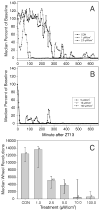Two components of nocturnal locomotor suppression by light
- PMID: 20484691
- PMCID: PMC3063651
- DOI: 10.1177/0748730410369890
Two components of nocturnal locomotor suppression by light
Abstract
In nocturnal rodents, millisecond light ("flash") stimuli can induce both a large circadian rhythm phase shift and an associated state change from highly active to quiescence followed by behavioral sleep. Suppression of locomotion ("negative masking") is an easily measured correlate of the state change. The present mouse studies used both flashes and longer light stimuli ("pulses") to distinguish initiation from maintenance effects of light on locomotor suppression and to determine whether the locomotor suppression exhibits temporal integration as is thought to be characteristic of phase shift responses to pulse, but not flash, stimuli. In experiment 1, locomotor suppression increased with irradiance (0.01-100 microW/cm( 2)), in accordance with previous reports. It also increased with stimulus duration (3-3000 sec), but interpretation of this result is complicated by the ability of light to both initiate and maintain locomotor suppression. In experiment 2, an irradiance response curve was determined using a stimulus series of 10 flashes, 2 msec each, with total flash energy varying from 0.0025 to 110.0 J/m(2). This included a test for temporal integration in which the effects of two equal energy series of flashes that differed in the number of flashes per series (10 vs 100), were compared. The 10 flash series more effectively elicited locomotor suppression than the 100 flash series, a result consistent with prior observations involving flash-induced phase shifts. In experiment 3, exposure of mice to an 11-h light stimulus yielded irradiance-dependent locomotor suppression that was maintained for the entire stimulus duration by a 100-microW/cm(2) stimulus. Light has the ability to initiate a time-limited (30-40 min) interval of locomotor suppression (initiation effect) that can be extended by additional light (maintenance effect). Temporal integration resembling that seen in phase-shifting responses to light does not exist for either phase shift or locomotor suppression responses to flashes or for locomotor suppression responses to light pulses. The authors present an alternative interpretation of data thought to demonstrate temporal integration in the regulation of phase shift responses to light pulses.
Figures






Similar articles
-
Light pulse duration differentially regulates mouse locomotor suppression and phase shifts.J Biol Rhythms. 2014 Oct;29(5):346-54. doi: 10.1177/0748730414547111. Epub 2014 Sep 17. J Biol Rhythms. 2014. PMID: 25231948
-
Millisecond light pulses make mice stop running, then display prolonged sleep-like behavior in the absence of light.J Biol Rhythms. 2009 Dec;24(6):497-508. doi: 10.1177/0748730409349059. J Biol Rhythms. 2009. PMID: 19926809 Free PMC article.
-
Absence of normal photic integration in the circadian visual system: response to millisecond light flashes.J Neurosci. 2007 Mar 28;27(13):3375-82. doi: 10.1523/JNEUROSCI.5496-06.2007. J Neurosci. 2007. PMID: 17392453 Free PMC article.
-
Nocturnal light and nocturnal rodents: similar regulation of disparate functions?J Biol Rhythms. 2013 Apr;28(2):95-106. doi: 10.1177/0748730413481921. J Biol Rhythms. 2013. PMID: 23606609 Review.
-
Neural basis and biological function of masking by light in mammals: suppression of melatonin and locomotor activity.Chronobiol Int. 2001 Sep;18(5):737-58. doi: 10.1081/cbi-100107511. Chronobiol Int. 2001. PMID: 11763983 Review.
Cited by
-
A Path to Sleep Is through the Eye.eNeuro. 2015 Mar 26;2(2):ENEURO.0069-14.2015. doi: 10.1523/ENEURO.0069-14.2015. eCollection 2015 Mar-Apr. eNeuro. 2015. PMID: 26464977 Free PMC article. Review.
-
Acute effects of light on the brain and behavior of diurnal Arvicanthis niloticus and nocturnal Mus musculus.Physiol Behav. 2015 Jan;138:75-86. doi: 10.1016/j.physbeh.2014.09.006. Epub 2014 Oct 28. Physiol Behav. 2015. PMID: 25447482 Free PMC article.
-
Separation of function for classical and ganglion cell photoreceptors with respect to circadian rhythm entrainment and induction of photosomnolence.Neuroscience. 2011 Dec 29;199:213-24. doi: 10.1016/j.neuroscience.2011.09.057. Epub 2011 Oct 4. Neuroscience. 2011. PMID: 21985934 Free PMC article.
-
Loss of Melanopsin Photoreception and Antagonism of the Histamine H3 Receptor by Ciproxifan Inhibit Light-Induced Sleep in Mice.PLoS One. 2015 Jun 17;10(6):e0128175. doi: 10.1371/journal.pone.0128175. eCollection 2015. PLoS One. 2015. PMID: 26083020 Free PMC article.
-
Drugs that prevent mouse sleep also block light-induced locomotor suppression, circadian rhythm phase shifts and the drop in core temperature.Neuroscience. 2013 Dec 19;254:98-109. doi: 10.1016/j.neuroscience.2013.09.025. Epub 2013 Sep 19. Neuroscience. 2013. PMID: 24056197 Free PMC article.
References
-
- Altimus CM, Guler AD, Lall G, Arman C, Sampath A, Pruskey G, Lucas R, Hattar S. An unexpected contribution of rods to circadian photoentrainment at all light intensities. 2009 Abstract 574.2.
-
- Aschoff J. Freerunning and entrained circadian rhythms. In: Aschoff J, editor. Handbook of Behavioral Neurobiology. Vol. 4. New York: Plenum; 1981. pp. 81–95.
-
- Daan S, Pittendrigh CS. A functional analysis of circadian pacemakers in nocturnal rodents. II. The variability of phase response curves. J Comp Physiol. 1976;106:253–266.
Publication types
MeSH terms
Grants and funding
LinkOut - more resources
Full Text Sources

